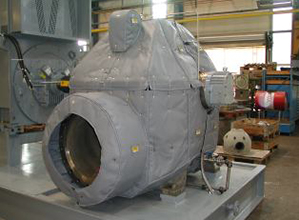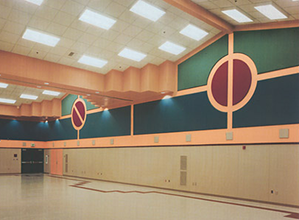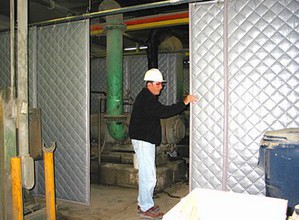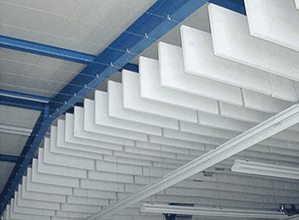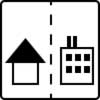Reverberant Room Noise Problems
In reverberant environments, acoustic reflections interfere with the direct sound arriving at a listener’s ears, distorting the spatial cues for sound localization. Typically echos, garbled speech, unintelligible speech and overall a loud unpleasant room.
FDA facilities are typically designed with cleaning in mind. Hard flat cleanable surfaces are all the finishes so mold growth is visible and all surfaces can be hosed down and washed for ease of disinfecting.
Gymnasiums, Natatoriums, Warehouses, Cafeterias, Multipurpose Rooms, Churches are many of the typical rooms that have a reverberation noise problem. Many times the rooms designers know there
will be a noise problem in the space because this is typical for these types of rooms. The reason no noise reduction material is added in the design and build phase is because the owner does not want to spend the extra cost of these materials. After the room is built and put into use to the tenants realize they have a noise problem and want to address it. 95% of the customers we work with are retrofitting a room because it is too noisy.
The solution to a room that is too noisy is adding acoustical absorption or sound absorbers. Sound absorbers are soft, porous, open-celled materials such as foam sheets, fiberglass panels or baffles that reduce the reflection of sound waves off of hard surfaces. Their sound absorption efficiency is rated by a “NRC” number, Noise Reduction Coefficient. The HIGHER the NRC rating, the more EFFICIENT the product is at absorbing noise. NRC is a sound absorption rating. It measures a percentage of how much sound will not be reflected back from where it came. Based on a range from .05 to 1.0, where a NRC of 1.0 means that all the sound energy that hits that product passes thru it and does not “bounce” back to its source. A NRC of .60 would reflect 40% of the sound back to the source, and let 60% of the noise pass
thru it.
We can calculate the current amount of sound absorption you have in your room. There are data bases with the sound absorption data for most building materials in third octave bands.
| Floor materials |
125 Hz |
250 Hz |
500 Hz |
1 kHz |
2 kHz |
4 kHz |
| Carpet |
0.01 |
0.02 |
0.06 |
0.15 |
0.25 |
0.45 |
| Concrete (sealed or painted) |
0.01 |
0.01 |
0.02 |
0.02 |
0.02 |
0.02 |
| Marble or glazed tile |
0.01 |
0.01 |
0.01 |
0.01 |
0.02 |
0.02 |
| Vinyl tile or linoleum |
0.02 |
0.03 |
0.03 |
0.03 |
0.03 |
0.02 |
| Wood parquet on concrete |
0.04 |
0.04 |
0.07 |
0.06 |
0.06 |
0.07 |
| Wood flooring on joists |
0.15 |
0.11 |
0.1 |
0.07 |
0.06 |
0.07 |
First, we take the square foot of surface area your room contains of each material and use the data from the material data base to add up what the current condition of your room. With this information as a baseline, we can add acoustical absorption to the room in square footage to achieve a Reverberation Time goal for that space.
| Absorber Materials |
125 Hz |
250 Hz |
500 Hz |
1 kHz |
2 kHz |
4 kHz |
| 2″ Baffle |
0.30 |
0.69 |
1.33 |
1.53 |
1.00 |
0.59 |
| 2″ Wall panel |
0.29 |
0.82 |
1.10 |
1.04 |
1.01 |
1.01 |
Different spaces have different suggested reverberation times. See below.
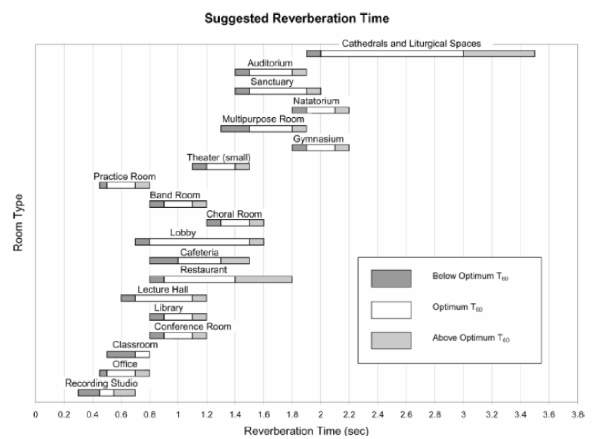
For example – Gyms have a suggested reverberation time of 1.8 to 2.2 seconds with 2.0 seconds being the optimum. Whereas a Conference Room has a suggested reverberation time of 1.0 seconds. The reverberation time determines the amount of absorption to add. You would typically need to add more sound absorption to achieve a 1.0 second reverberation time than a 2.0 second reverberation time.
Factories and manufacturing facilities have no published recommended reverberation times. Typically, these buildings are large reverberant spaces similar construction as a gymnasium. I typically use a 2.0 second reverberation time goal for these spaces to provide a good sound reduction and better acoustics without going overboard on the added absorption.
We can also design for a decibel reduction goal. Because adding acoustical absorption only treats the acoustics in the room and not the direct sound emanating from a piece of equipment, there are limitations to sound reduction expectations. Typically adding acoustical absorption to a space you can get 4-8 dBA reduction.
Reverberation time report, Clean Room application, FDA Sanitary Acoustical Baffles Solution
| Room Dimensions |
|
|
|
|
|
|
|
|
|
|
|
|
| Recommended Reverberation Time – T60: |
|
|
|
|
|
Octave Band Center Frequencies |
|
| 125 HZ |
250 HZ |
500 HZ |
1000 HZ |
2000 HZ |
4000 HZ |
|
| Recommended T60 (sec) |
| 2.00 |
2.00 |
2.00 |
2.00 |
2.00 |
2.00 |
|
|
|
|
|
| Current Conditions |
|
|
|
|
| Location |
Material |
Area Covered (ft2) |
|
Absorption Coefficient(a) or Sabins/ft2
Octave Band Center Frequencies |
|
| 125 HZ |
250 HZ |
500 HZ |
1000 HZ |
2000 HZ |
4000 HZ |
|
|
|
| 0.02 |
0.02 |
0.03 |
0.04 |
0.04 |
0.03 |
|
|
|
| 0.10 |
0.08 |
0.05 |
0.03 |
0.03 |
0.03 |
|
|
|
| 0.02 |
0.02 |
0.03 |
0.04 |
0.04 |
0.03 |
|
|
|
|
|
| Total Absorption |
|
|
|
|
| Location |
Material |
Area Covered (ft2) |
|
Absorption Coefficient(a) or Sabins/ft2
Octave Band Center Frequencies |
|
| 125 HZ |
250 HZ |
500 HZ |
1000 HZ |
2000 HZ |
4000 HZ |
|
|
|
| 42.80 |
42.80 |
64.20 |
85.60 |
85.60 |
64.20 |
|
|
|
| 282.00 |
225.60 |
141.00 |
84.60 |
84.60 |
84.60 |
|
|
|
| 56.40 |
56.40 |
84.60 |
112.80 |
112.80 |
84.60 |
|
|
|
| 381.20 |
324.80 |
289.80 |
283.00 |
283.00 |
233.40 |
|
|
|
|
|
| Estimated Reverberation Time With Current Conditions |
|
|
|
|
|
|
|
|
| V = room volume in cubic feet |
|
| A = total acoustical absorption in the room in sabins |
|
|
|
|
|
|
Octave Band Center Frequencies |
|
| 125 HZ |
250 HZ |
500 HZ |
1000 HZ |
2000 HZ |
4000 HZ |
|
| Estimated T60 (sec) |
| 3.62 |
4.25 |
4.77 |
4.88 |
4.88 |
5.92 |
|
| Amount Above Recommended T60 (sec) |
| 1.62 |
2.25 |
2.77 |
2.88 |
2.88 |
3.92 |
|
|
|
|
|
| Added eNoise Control Materials |
|
|
|
|
| Location |
Material |
Area Covered (ft2) |
|
Absorption Coefficient(a) or Sabins/ft2
Octave Band Center Frequencies |
|
| 125 HZ |
250 HZ |
500 HZ |
1000 HZ |
2000 HZ |
4000 HZ |
|
|
|
| 0.10 |
0.08 |
0.05 |
0.03 |
0.03 |
0.03 |
|
|
|
| 0.05 |
0.04 |
0.03 |
0.03 |
0.02 |
0.01 |
|
|
|
| 0.02 |
0.02 |
0.03 |
0.04 |
0.04 |
0.03 |
|
|
|
| 0.13 |
1.01 |
1.83 |
1.97 |
1.59 |
0.62 |
|
|
|
|
|
| Total Absorption of Added eNoise Control Material |
|
|
|
|
| Location |
Material |
Area Covered (ft2) |
|
Absorption Coefficient(a) or Sabins/ft2
Octave Band Center Frequencies |
|
| 125 HZ |
250 HZ |
500 HZ |
1000 HZ |
2000 HZ |
4000 HZ |
|
|
|
| 42.80 |
42.80 |
64.20 |
85.60 |
85.60 |
64.20 |
|
|
|
| 282.00 |
225.60 |
141.00 |
84.60 |
84.60 |
84.60 |
|
|
|
| 56.40 |
56.40 |
84.60 |
112.80 |
112.80 |
84.60 |
|
|
|
| 28.60 |
222.20 |
402.60 |
433.40 |
349.80 |
136.40 |
|
|
|
| 409.80 |
547.00 |
692.40 |
716.40 |
632.80 |
369.80 |
|
|
|
|
|
| Estimated Reverberation Time with Current Conditions |
|
|
|
|
|
Octave Band Center Frequencies |
|
| 125 HZ |
250 HZ |
500 HZ |
1000 HZ |
2000 HZ |
4000 HZ |
|
| T60 (sec) After Treatment |
| 3.37 |
2.53 |
2.00 |
1.93 |
2.18 |
3.74 |
|
|
|
|
|
| Sound Level Reduction |
|
|
|
|
| Level Reduction |
10 Log 10 |
Over |
|
|
|
| A2 = Total Amount of sound absorption before treatment |
|
| A1 = Total Amount of sound absorption after treatment |
|
|
|
|
|
|
Octave Band Center Frequencies |
|
| 125 HZ |
250 HZ |
500 HZ |
1000 HZ |
2000 HZ |
4000 HZ |
|
| Sound Level Reduction After Treatment |
| 0.31 |
2.26 |
3.78 |
4.03 |
3.49 |
2.00 |
|
|
|
|
|
| Summary Of Results |
|
|
|
|
|
Octave Band Center Frequencies |
|
| 125 HZ |
250 HZ |
500 HZ |
1000 HZ |
2000 HZ |
4000 HZ |
|
| T60 Before Treatment |
| 3.62 |
4.25 |
4.77 |
4.88 |
4.88 |
5.92 |
|
| Recommended T60 (sec) |
| 2.00 |
2.00 |
2.00 |
2.00 |
2.00 |
2.00 |
|
| T60 (sec) After Treatment |
| 3.37 |
2.53 |
2.00 |
1.93 |
2.18 |
3.74 |
|
|
|
A few things to note:
- Large spaces typically require large amounts of acoustical absorption.
- There is a threshold amount of absorption you need to add to a space to hear the performance.
Example: You cannot add a couple of 2’ x 4’ panels to a large gym and notice a difference in the sound
level.
- Most acoustical ceiling tile have an NRC Rating of 0.45 or above. If your entire ceiling is covered with acoustical ceiling tile, you should not have a reverberation problem, nor can we calculate that you do.
- Most large public spaces have fire protection sprinklers near the ceiling deck. Typically, you cannot hang acoustical baffles in spaces that have fire protection because they will impede the throw of the sprinklers and not function correctly. You will need to mount panels flush with the ceiling deck or hang the panels on the walls.
